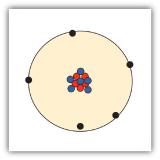3: Atoms, Molecules and Ions (Exercises)
- Page ID
- 156467
\( \newcommand{\vecs}[1]{\overset { \scriptstyle \rightharpoonup} {\mathbf{#1}} } \)
\( \newcommand{\vecd}[1]{\overset{-\!-\!\rightharpoonup}{\vphantom{a}\smash {#1}}} \)
\( \newcommand{\id}{\mathrm{id}}\) \( \newcommand{\Span}{\mathrm{span}}\)
( \newcommand{\kernel}{\mathrm{null}\,}\) \( \newcommand{\range}{\mathrm{range}\,}\)
\( \newcommand{\RealPart}{\mathrm{Re}}\) \( \newcommand{\ImaginaryPart}{\mathrm{Im}}\)
\( \newcommand{\Argument}{\mathrm{Arg}}\) \( \newcommand{\norm}[1]{\| #1 \|}\)
\( \newcommand{\inner}[2]{\langle #1, #2 \rangle}\)
\( \newcommand{\Span}{\mathrm{span}}\)
\( \newcommand{\id}{\mathrm{id}}\)
\( \newcommand{\Span}{\mathrm{span}}\)
\( \newcommand{\kernel}{\mathrm{null}\,}\)
\( \newcommand{\range}{\mathrm{range}\,}\)
\( \newcommand{\RealPart}{\mathrm{Re}}\)
\( \newcommand{\ImaginaryPart}{\mathrm{Im}}\)
\( \newcommand{\Argument}{\mathrm{Arg}}\)
\( \newcommand{\norm}[1]{\| #1 \|}\)
\( \newcommand{\inner}[2]{\langle #1, #2 \rangle}\)
\( \newcommand{\Span}{\mathrm{span}}\) \( \newcommand{\AA}{\unicode[.8,0]{x212B}}\)
\( \newcommand{\vectorA}[1]{\vec{#1}} % arrow\)
\( \newcommand{\vectorAt}[1]{\vec{\text{#1}}} % arrow\)
\( \newcommand{\vectorB}[1]{\overset { \scriptstyle \rightharpoonup} {\mathbf{#1}} } \)
\( \newcommand{\vectorC}[1]{\textbf{#1}} \)
\( \newcommand{\vectorD}[1]{\overrightarrow{#1}} \)
\( \newcommand{\vectorDt}[1]{\overrightarrow{\text{#1}}} \)
\( \newcommand{\vectE}[1]{\overset{-\!-\!\rightharpoonup}{\vphantom{a}\smash{\mathbf {#1}}}} \)
\( \newcommand{\vecs}[1]{\overset { \scriptstyle \rightharpoonup} {\mathbf{#1}} } \)
\( \newcommand{\vecd}[1]{\overset{-\!-\!\rightharpoonup}{\vphantom{a}\smash {#1}}} \)
\(\newcommand{\avec}{\mathbf a}\) \(\newcommand{\bvec}{\mathbf b}\) \(\newcommand{\cvec}{\mathbf c}\) \(\newcommand{\dvec}{\mathbf d}\) \(\newcommand{\dtil}{\widetilde{\mathbf d}}\) \(\newcommand{\evec}{\mathbf e}\) \(\newcommand{\fvec}{\mathbf f}\) \(\newcommand{\nvec}{\mathbf n}\) \(\newcommand{\pvec}{\mathbf p}\) \(\newcommand{\qvec}{\mathbf q}\) \(\newcommand{\svec}{\mathbf s}\) \(\newcommand{\tvec}{\mathbf t}\) \(\newcommand{\uvec}{\mathbf u}\) \(\newcommand{\vvec}{\mathbf v}\) \(\newcommand{\wvec}{\mathbf w}\) \(\newcommand{\xvec}{\mathbf x}\) \(\newcommand{\yvec}{\mathbf y}\) \(\newcommand{\zvec}{\mathbf z}\) \(\newcommand{\rvec}{\mathbf r}\) \(\newcommand{\mvec}{\mathbf m}\) \(\newcommand{\zerovec}{\mathbf 0}\) \(\newcommand{\onevec}{\mathbf 1}\) \(\newcommand{\real}{\mathbb R}\) \(\newcommand{\twovec}[2]{\left[\begin{array}{r}#1 \\ #2 \end{array}\right]}\) \(\newcommand{\ctwovec}[2]{\left[\begin{array}{c}#1 \\ #2 \end{array}\right]}\) \(\newcommand{\threevec}[3]{\left[\begin{array}{r}#1 \\ #2 \\ #3 \end{array}\right]}\) \(\newcommand{\cthreevec}[3]{\left[\begin{array}{c}#1 \\ #2 \\ #3 \end{array}\right]}\) \(\newcommand{\fourvec}[4]{\left[\begin{array}{r}#1 \\ #2 \\ #3 \\ #4 \end{array}\right]}\) \(\newcommand{\cfourvec}[4]{\left[\begin{array}{c}#1 \\ #2 \\ #3 \\ #4 \end{array}\right]}\) \(\newcommand{\fivevec}[5]{\left[\begin{array}{r}#1 \\ #2 \\ #3 \\ #4 \\ #5 \\ \end{array}\right]}\) \(\newcommand{\cfivevec}[5]{\left[\begin{array}{c}#1 \\ #2 \\ #3 \\ #4 \\ #5 \\ \end{array}\right]}\) \(\newcommand{\mattwo}[4]{\left[\begin{array}{rr}#1 \amp #2 \\ #3 \amp #4 \\ \end{array}\right]}\) \(\newcommand{\laspan}[1]{\text{Span}\{#1\}}\) \(\newcommand{\bcal}{\cal B}\) \(\newcommand{\ccal}{\cal C}\) \(\newcommand{\scal}{\cal S}\) \(\newcommand{\wcal}{\cal W}\) \(\newcommand{\ecal}{\cal E}\) \(\newcommand{\coords}[2]{\left\{#1\right\}_{#2}}\) \(\newcommand{\gray}[1]{\color{gray}{#1}}\) \(\newcommand{\lgray}[1]{\color{lightgray}{#1}}\) \(\newcommand{\rank}{\operatorname{rank}}\) \(\newcommand{\row}{\text{Row}}\) \(\newcommand{\col}{\text{Col}}\) \(\renewcommand{\row}{\text{Row}}\) \(\newcommand{\nul}{\text{Nul}}\) \(\newcommand{\var}{\text{Var}}\) \(\newcommand{\corr}{\text{corr}}\) \(\newcommand{\len}[1]{\left|#1\right|}\) \(\newcommand{\bbar}{\overline{\bvec}}\) \(\newcommand{\bhat}{\widehat{\bvec}}\) \(\newcommand{\bperp}{\bvec^\perp}\) \(\newcommand{\xhat}{\widehat{\xvec}}\) \(\newcommand{\vhat}{\widehat{\vvec}}\) \(\newcommand{\uhat}{\widehat{\uvec}}\) \(\newcommand{\what}{\widehat{\wvec}}\) \(\newcommand{\Sighat}{\widehat{\Sigma}}\) \(\newcommand{\lt}{<}\) \(\newcommand{\gt}{>}\) \(\newcommand{\amp}{&}\) \(\definecolor{fillinmathshade}{gray}{0.9}\)3.1: Atomic Theory
- List the three statements that make up the modern atomic theory.
-
Explain how atoms are composed.
-
Which is larger, a proton or an electron?
-
Which is larger, a neutron or an electron?
-
What are the charges for each of the three subatomic particles?
-
Where is most of the mass of an atom located?
-
Sketch a diagram of a boron atom, which has five protons and six neutrons in its nucleus.
-
Sketch a diagram of a helium atom, which has two protons and two neutrons in its nucleus.
-
Define atomic number. What is the atomic number for a boron atom?
-
What is the atomic number of helium?
-
Define isotope and give an example.
-
What is the difference between deuterium and tritium?
13. Which pair represents isotopes?
- \[_{2}^{4}\textrm{He} \, and\: \, _{2}^{3}\textrm{He}\]
- \[_{26}^{56}\textrm{Fe} \, and\: \, _{25}^{56}\textrm{Mn}\]
- \[_{14}^{28}\textrm{Si} \, and\: \, _{15}^{31}\textrm{P}\]
14. Which pair represents isotopes?
- \[_{20}^{40}\textrm{Ca} \, and\: \, _{19}^{40}\textrm{K}\]
- \[_{26}^{56}\textrm{Fe} \, and\: \, _{28}^{56}\textrm{Fe}\]
- \[_{92}^{238}\textrm{U} \, and\: \, _{92}^{235}\textrm{U}\]
- Give complete symbols of each atom, including the atomic number and the mass number.
- an oxygen atom with 8 protons and 8 neutrons
- a potassium atom with 19 protons and 20 neutrons
- a lithium atom with 3 protons and 4 neutrons
- Give complete symbols of each atom, including the atomic number and the mass number.
- a magnesium atom with 12 protons and 12 neutrons
- a magnesium atom with 12 protons and 13 neutrons
- a xenon atom with 54 protons and 77 neutrons
-
Americium-241 is an isotope used in smoke detectors. What is the complete symbol for this isotope?
-
Carbon-14 is an isotope used to perform radioactive dating tests on previously living material. What is the complete symbol for this isotope?
-
-
Give atomic symbols for each element.
- sodium
- argon
- nitrogen
- radon
-
-
-
Give atomic symbols for each element.
- silver
- gold
- mercury
- iodine
-
-
-
Give the name of the element.
- Si
- Mn
- Fe
- Cr
-
-
-
Give the name of the element.
- F
- Cl
- Br
- I
-
- All matter is composed of atoms; atoms of the same element are the same, and atoms of different elements are different; atoms combine in whole-number ratios to form compounds.
-
-
A proton is larger than an electron.
-
proton: 1+; electron: 1−; neutron: 0
- The atomic number is the number of protons in a nucleus. Boron has an atomic number of five.
-
-
Isotopes are atoms of the same element but with different numbers of neutrons. \[_{1}^{1}\textrm{H} \, and\: \, _{1}^{2}\textrm{H}\]
-
- isotopes
- not isotopes
- not isotopes
-
-
\[_{8}^{16}\textrm{O}\]
-
\[_{19}^{39}\textrm{K}\]
-
\[_{3}^{7}\textrm{Li}\]
-
-
\[_{95}^{241}\textrm{Am}\]
-
-
Na
-
Ar
-
N
-
Rn
-
-
- silicon
- manganese
- iron
- chromium


